To the inmates who were confined on this island
prison, in operation from 1934 to 1963, their punishment was not only
captivity but also psychological torture. After all, they were right in
the midst of one of America’s busiest harbors, with small craft darting
to and from San Francisco, Oakland, Berkeley, and Sausalito, and they
could probably hear the ceaseless procession of automobiles crossing the
bridges and honking their horns. They could certainly see the ocean
liners as they glided through the Golden Gate to far away ports – all
reminding them that life was near, but freedom very far.
Alcatraz Cruises (Horn blower)From Pier 33 415 981 7625 (tickets and schedules)
www.nps.gov/alcatraz
Open daily Adm:
day tours – $15.25 child 5–11 years, $24.50 adult; night tours – $18.75
child 5–11 years, $31.50 adult; family packages available
|
|
The name “Alcatraz” derives from the Spanish alcatraces,
for the birds that Spanish explorer Juan Manuel de Ayala observed here
when he sailed into the Bay in 1775. In 1850, a presidential order set
aside the island for the US Army to build a citadel, but defense became
less of a priority and, in 1909, it became a military prison. In 1933
the Federal Government decided to open a maximum-security penitentiary
here. Yet Alcatraz was not the “Devil’s Island” that many think it was –
the conditions, such as one man per cell, were better than other jails.
|

View of Alcatraz Island from San Francisco
|
Picnicking is allowed on the dock, but you’ll have to bring your own food. The visitor center does sell water, however.
|
|
|
The weather is often
blustery and cold on the island, and the trails and walkways rough. Wear
warm clothes and strong, comfortable shoes.
|
|
|
The audioguide is well worth the extra few dollars, as is the ranger-guided tour.
|
|
|
You cannot visit Alcatraz independently – booking a guided tour with the ferry company is required.
|
|
Top 10 FeaturesLighthouse Alcatraz
Island was the site of the very first lighthouse built on the West
Coast in 1854. The original lighthouse was replaced in 1909 with an
automated one, to tower above the new cell block. Cell Blocks The
cell house contains four free-standing cell blocks. The complex was
built by military prisoners in 1911 and was once the largest reinforced
concrete building in the world. In all, there were 390 cells, but the
population averaged only about 260 at any one time.
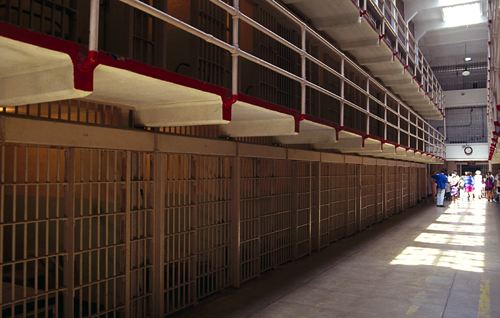
Exercise Yard With
a strict “no-talking” rule and the monotonous gloom of being cut off
from life, prisoners whose good behavior qualified them for a turn
around the walled-in Exercise Yard must have felt very relieved. Here
they could walk, rather than pace in their cells, where they spent 16 to
23 hours every day.
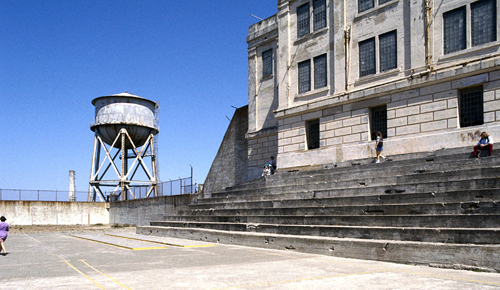
Control Room From
this bunker-like facility, reinforced to withstand siege, the guards
controlled the 24-hour electric security system. Next to the Control
Room was the visiting area, where thick glass separated prisoners and
visitors, and conversations were held over monitored telephones. D Block Any
prisoner who transgressed the strict rules and regulations would be
sent to D Block, the 42 solitary confinement cells kept entirely without
light.
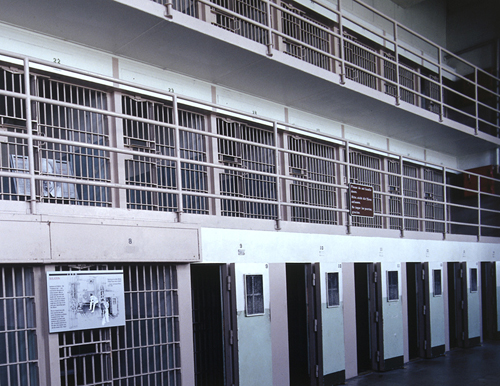
Dining Room Meals
were one of the few things prisoners had to look forward to, and they
were generally well-fed, to quell rebellion. Note the sample menu on
display at the kitchen entrance. Chapel On
top of the guardhouse, a Mission-style military chapel was built during
the 1920s. It was used as living quarters and a school, as well as a
chapel. During the post-1930s prison phase, the building was used to
house prison staff.
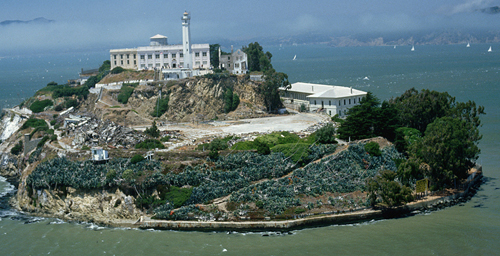
Broadway The
corridor that separates C and B blocks was jokingly nicknamed by
prisoners after New York City’s glittering thoroughfare, famous for its
nightlife. The intersection at the end was named “Times Square.”
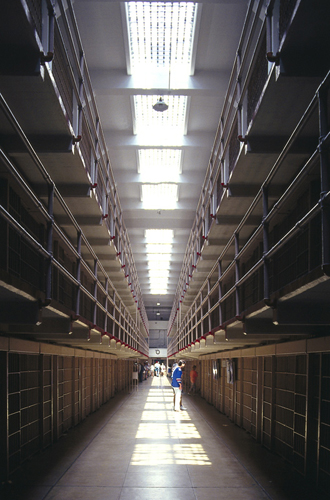
Visitor Center The
Visitor Center is located in the old barracks building behind the ferry
jetty. It houses a bookstore, exhibits, and a multimedia show providing
a historical overview of Alcatraz, and an information counter.
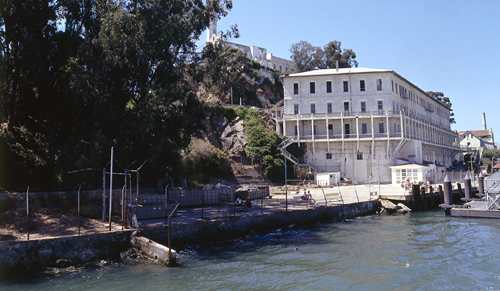
Warden’s House Until
the house burned down in 1970, the warden’s home looked out to freedom.
Designed in Mission Revival style, the home had 17 large rooms, and
sweeping views of the Golden Gate Bridge and San Francisco lights.
Stories from The Rock
Robert “Birdman” Stroud The
most famous inmate was dubbed the “Birdman”, despite the fact that he
was not permitted to conduct his avian studies during his 17 years here.
Due to his violent nature Stroud spent most of those years in solitary. Birdman of Alcatraz This 1962 movie presented Stroud as a nature-loving ornithologist, bending historical fact to the service of a good story. Al Capone In
1934 Capone was among the first “official” shipment of prisoners. The
infamous gangster was assigned menial jobs and treated like every other
inmate.
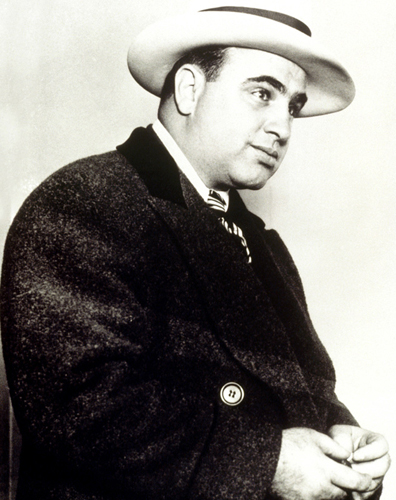
Al Capone
George “Machine Gun” Kelly Jailed
in 1933 for kidnapping, Kelly was given a life sentence, and was sent
to Alcatraz for 17 years. He was considered a model prisoner by the
officers. Alvin “Creepy” Karpis Karpis
robbed his way through the Midwest between 1931 and 1936, and earned
himself the title Public Enemy Number One. He was imprisoned on Alcatraz
from 1936 to 1962. He committed suicide in 1979. Morton Sobell Charged
with conspiracy to commit treason, Sobell arrived on Alcatraz in 1952
and spent five years as its most famous political prisoner, being a
victim of J. Edgar Hoover’s witch hunt for Communist subversives. Once
freed, Sobell returned to live in San Francisco, where he still resides
today. Anglin Brothers The brothers, John and Clarence, are notable as the only two known inmates to successfully escape from The Rock. Escape from Alcatraz Starring
Clint Eastwood as one of the Anglin brothers, again, this 1979 film is
largely Hollywood fiction. However, the depiction of prison life is
reportedly accurate. Frank Wathernam The last prisoner to leave Alcatraz, on March 21, 1963. The Rock Hollywood has never lost its fascination with Alcatraz, as can be seen in this 1997 action thriller, starring Sean Connery.
Native American Occupation
In 1969 Richard Oakes and 90 Native
Americans landed on Alcatraz, set up camp, and demanded the government
sell them the island for $24 worth of beads and red cloth. They claimed
that this was the price their people had been paid in exchange for an
island similar in size nearly 300 years earlier. The government
considered forcibly removing the occupiers, but growing public support
for the Indians forced officials to renew negotiations. However, in
January 1970, while playing on the rooftop of one of the buildings,
Oakes’ youngest daughter slipped and fell to her death; distraught, he
and his family decided to abandon their claim. Sixty Native Americans
remained, but as the stalemate dragged on, the majority slowly began to
leave – only 15 chose to stay. In June 1970, fires ravaged the warden’s
house, the recreation hall, the officers’ club, and the lighthouse.
Following this devastation, government troops staged a pre-dawn raid.
The remaining Indians were arrested and the 19-month Indian occupation
came to an end.
Top 10 Escape AttemptsDecember, 1937: Theodore Cole & Ralph Roe May, 1938: James Limerick, Jimmy Lucas, & Rufus Franklin January, 1939: Arthur “Doc” Barker, Dale Stamphill, William Martin, Henry Young, & Rufus McCain May, 1941: Joe Cretzer, Sam Shockley, Arnold Kyle, & Lloyd Barkdoll April, 1943: James Boarman, Harold Brest, Floyd Hamilton, & Fred Hunter May, 1946: Bernard Coy, Joe Cretzer, Marvin Hubbard, Sam Shockley, Miran Thompson, & Clarence Carnes September, 1958: Aaron Burgett & Clyde Johnson June, 1962: Frank Morris & John and Clarence Anglin December, 1962: John Paul Scott & Darl Parker
|